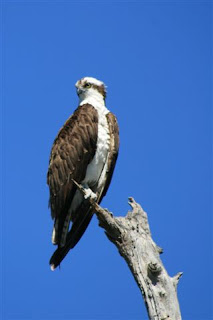Bob Stanowski at Bantam Lake's Outlet
in October, 2010
photographed by Bob Stanowski
at White Memorial's Pike Marsh
in April, 2007
Darlene Knox in Florida
in March, 2011
We recorded White Memorial's first Osprey sighting of 2011 this past Saturday, 4/2, at the Litchfield Town Beach. The bird flew in from the Bantam Lake Inlet with a 12" (or so) fish that appeared to be a White Sucker. We think that this was the correct identification of this fish species, even though we didn't see its head, because its body was slim, and it had a white belly, greenish-brown sides, and a deeply forked tail. This latter body part flapped up and down for close to 10 minutes while we watched the Osprey slowly consume the fish from the head on back while it perched on a tree branch about 100' from us. Unfortunately, neither of us had a camera with us. An Osprey that was seen in the same area the next day and frequently yesterday could have either been this bird or a different one. We also have no way of knowing whether this bird is a resident back on territory or a migrant passing through since very few of these birds are fitted with colored and lettered or numbered leg bands. Though many young Ospreys are banded as nestlings at coastal sites from Maine to Florida every year, they are only fitted with a silver U.S. Fish and Wildlife Service band on the right leg. They do carry serial numbers, but the bands are next to impossible to read, even with the best spotting scopes. By contrast, some of the colored leg bands on Bald Eagles do have letter and number combinations that can be read with a good scope. Also, a sizable and increasing number of young Ospreys are being produced from nesting pairs at inland bodies of water, especially in New York, northern New England, and Canada. These birds are seldom banded due to the combination of the shear number of birds involved, nest site accessability issues, and a low number of Federally-licensed banders. Getting back to the Ospreys at Bantam Lake and elsewhere around White Memorial, it is interesting to note that we almost always see our first one of the year around 4/1, give or take 3 days. This has been the case for the past 15 years. Over this time span we have seen a steadily increasing number of these birds passing through here northbound in the spring and southbound in the fall. Starting about 6 years ago, one or two Ospreys were seen with some regularity around Bantam Lake's N. Bay during the months of June and July. Since the breeding season for these birds is typically from early April through late July in CT., the birds around here could have been establishing a breeding territory. That was confirmed in late April of 2009 when I saw them carrying sticks into a clump of rather short Red Maples in the N. Shore Marsh. For such large birds with a large nest they remained amazingly well-hidden. We didn't find out the outcome of this nesting attempt until late July when a fledgling appeared with the adults on the east side of this marsh. They were seen a few times before they departed in late August. In 2010, the Ospreys returned, but moved farther up the Bantam River from Bantam Lake by at least a quarter mile. This may have been due to the pair of Bald Eagles becoming increasingly territorial at the Lake. Bald Eagles and Ospreys do not get along well with each other. We saw stick-carrying by the Ospreys in late April, and a fledgling with them a few times in late July and early August, indicating a second year of successful nesting by these birds. It will be interesting to see if they threepeat in 2011.




1 comment:
Is this happening elsewhere in inland CT and what is the driving force behind this expansion?
J
Post a Comment